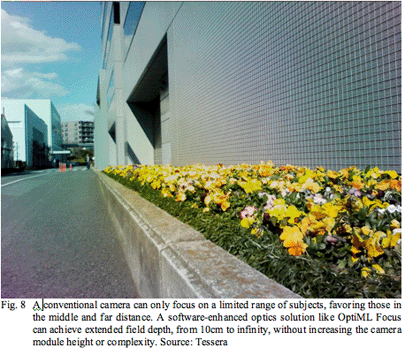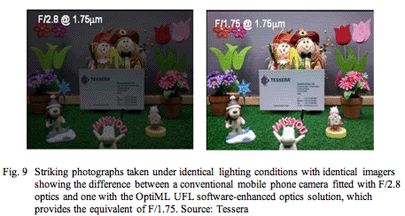This four-part series explores trends in image capture and processing and design challenges on mobile phones and other handheld devices. This section focuses on the use of software to enhance optical performance.
This article refers to the address: http://
The invention of wafer-scale manufacturing technology makes it possible to produce and compact camera modules at very low cost. For physical reasons, a small camera module is inferior to a larger camera module, but the defects produced by the small camera module can be corrected by a new wafer-scale lens structure. However, this can only be used to maintain the status quo, to improve image quality and to enhance the user experience.
Currently, designers of high-resolution camera phones have been able to market their products to consumers only by highlighting the number of pixels. With the widespread use of camera phones (more than 80% of mobile phones have at least one camera installed), consumers have realized that there is no necessary connection between the quality of the image and its number of pixels. In fact, the stunning picture uploaded from the Mars Rover was taken with a camera that was only 1M pixel. Similarly, designers of professional-grade cameras have long known that in order to obtain a higher quality digital picture, optical and software cooperation is required.
As discussed in the first part of this article, customer needs have improved the image quality of a new camera phone and a range of embedded features. One of the most anticipated is optical zoom, focus, and low optical sensitivity, such as taking pictures without flash. All of these features are relatively simple to implement, provided that height and cost are allowed, especially for zooming. Traditional zoom requires two lenses to make relative motion on the optical axis within the camera. This can be done with a microdrive, but the final product will be bulky, power consuming, slow to respond, and not compatible with the harsh environment of portable electronic devices, especially the "drop test." Therefore, how can the designers of camera models provide all the features consumers need to improve the quality of the image without affecting the appearance, reliability and most important cost of the product? The answer is software-enhanced optics.
Software enhanced optics
Software-enhanced optics, or "smart optics," is a correction technique for image processing of known optical effects. Optical effects can be inherent defects that must be corrected, or intentionally introduce an artificial correction that provides a function or specific effect. If the goal is simply to improve the quality of the image, then you can purchase high-quality, high-precision optical equipment without the investment, and the known distortion caused by the inexpensive optical lens bin can be corrected by software. For example, if size and cost are limited, it means that the corners of the image always have the same degree of ambiguity, and software-enhanced optics can apply edge sharpening algorithms to correct these corner regions. Then, the user will be satisfied with such pictures, because the defects inherent in these camera modules can be corrected or masked, and the pictures presented are good in all departments. For further efficiency, this correction can be completely transparent to the user, ie without user intervention.
With this software to enhance the concept of optics, new opportunities are everywhere. The basic method is to use a professional lens that operates the light as it enters the camera, distributing the light on the imager as needed. The image being manipulated is not used directly, it requires further correction by the software. However, since the image is operated in a known manner, it can be digitally restored, so that a high quality output is presented. This allows for many functions, including full-optical zoom with no moving parts, extended depth of field, and small F-value optical performance in low-visibility environments.
A software-enhanced optical solution for optical zoom takes advantage of the fact that in conventional optical lens bins, the density of information is inconsistent across the field of view. The center area contains more data, and the edges are reversed. However, an image sensor has a regular, two-dimensional array of pixels. This means that when framing, the center of the imager is normal sampling and the edges are oversampled. The software-enhanced optics solution utilizes a specially designed pixel lens to provide a non-uniform distribution of optical sensing performance within the field of view that matches the quantized format of the solid-state imager. In effect, this is contrary to the traditional approach taken by nature. Many animals with single-aperture eyes, especially birds, have a standard "lens", but the ducts and cones on the retina are non-uniformly distributed. In both cases, the image is distorted, but it can be corrected because the lens design and the pixel distribution of the imager (or retina) are known.
In order to be able to view at the same magnification, the algorithm must compress the details of the central region of the field of view, as the professional lens adds magnification and resolution in this region. Therefore, compression does not degrade the quality of the image, but in fact, the software-enhanced lens solution in such a design can make the image quality the same as that produced by a conventional camera. When the image is zoomed, the border of the image appears and the enlarged center area is preserved. The image will then be corrected for distortion. This is the biggest difference from digital zoom because zoom is the result of lens motion and has been fixed during image acquisition, so the zoomed image retains its original, higher resolution. Software-enhanced optics can achieve 3x zoom.
The figure is an example of using software-enhanced optics to provide zoom functionality. In this solution, there are no moving parts, that is, physically compact, rugged, instantaneously visible, low in power consumption, and thus low in cost. This is significantly better than digital zoom. Digital zoom involves trimming and expanding the image to fill the field of view, which naturally reduces the resolution because the available information will be spread over a larger area. In a 3x digital zoom, almost 90% of the quality information is lost during image acquisition, which is why digital zoom provides only a small multiplier. The image enhancement solution for zooming can be achieved with a fixed lens and a simple algorithm. This makes this solution suitable for all imager technologies and all resolutions (from QCIF to >10M pixels), so it is expected to be widely used in camera phones in the short term.

Fig. Optical zoom achieved with OptiMLTM Zoom Software Enhanced Optical Solution (only the central area of ​​the field of view is displayed) (left) Image before distortion correction (middle) Distortion corrected image with 1x optical zoom (right) Figure) Distortion corrected image after 2x optical zoom. Source: Tessera
The pictures obtained by taking pictures of the mobile phone are often from the "immediate rise". Consumers don't want the scene to be arranged, and there will be no time or trouble to put the camera and themselves in the most appropriate place from the target. With these small optics, a conventional camera module only needs to focus on a target within a certain distance, typically 60 cm to tens of meters. Due to the failure to understand and comply with this limitation, consumers are often not satisfied with the images they have imaged themselves. The image enhancement solution for this problem is "extended depth of field". This causes all the details of the scene to be focused, as long as these details are within 10 cm of the camera module to infinity. Similar to the software-enhanced lens zoom scheme, this can be achieved by the combination of optical magnification provided by a professional lens and a simple algorithm. It does not involve any moving parts and is therefore rugged, reliable, instantaneous and low power.
In conventional camera modules, the optical lens bin is designed to focus the source point and is therefore placed at a certain distance from the imager within the camera. If the lens cannot focus or the target is too close to the lens, the spot will appear in the diffuse area, so the image will become blurred. The law that this lens transforms the light source into a blurred spot can be described as a mathematical change called the point spread function. If the point spread function of the lens is known, blur can be restored to the original live scene by using digital signal processing. However, when only a certain area of ​​the picture is out of focus, no matter what transformation method is used, it cannot be reliably identified. Software-enhanced optics solves this problem by refocusing the entire image in a controlled way. The lens effectively creates an image that is as sharp as the source, which can be de-interleaved by a straightforward algorithm. The result is a better, clearer image, regardless of foreground, medium or distant view. Figure 8 gives a good example.

Figure. A traditional lens can only focus on a limited range of targets, especially at medium and long distances; a software-enhanced optical solution, such as OptiML focusing, can achieve extended depth of field, from 10 cm to infinity, There is no need to increase the height or complexity of the camera module. Source: Tessera
One of the main complaints about camera phones is their performance at low visibility. In fact, this is only a semi-truth proposition. The compact size of the compact camera module undoubtedly results in a reduction in optical sensitivity relative to digital still cameras. From a pixel size of 2.2μm in 2007 to 1.75μm in 2008, it is expected to grow to 1.4μm in 2009 and eventually reach 1.1μm, a trend that has a significant impact on low visibility performance and image quality. In short, as the pixel size decreases, its sensitivity also decreases. From a more technical point of view, the ability of a photodiode to absorb photons and release electrons diminishes as the pixel decreases. Other corresponding effects of small pixel size include the dynamic range and the reduced signal to noise ratio. In reality, the perception of poor low-visibility performance of camera phones is more importantly caused by more and more photographs in low-visibility environments; typically, at night and in places such as clubs and restaurants, in these places. The light intensity is about 5 lux, which is much less than >350 lux outside the day. Due to the reduced brightness, the quality of the picture obtained from the digital imager naturally deteriorates rapidly, with the appearance of defects such as increased noise, loss of detail or color errors.
An important reason for the lack of low visibility performance of camera phones is that the F value of the optical lens bin cannot be changed because it must be fixed at the time of manufacture. Most digital still cameras offer an option to increase the aperture to compensate for the reduction in the number of photons in dimly lit scenes. However, mechanically adjustable apertures can make the fuselage large, unsturdy, slow in response and high in power consumption. Simply lowering the F-number of a fixed-aperture camera to improve low-light sensitivity is not a good choice, as a larger aperture reduces the depth of field, making it difficult to obtain a good image quality when the scene has depth of field. Typically, standard camera phones use an aperture between F/2.8 and F/2.4, primarily to preserve enough depth to focus on normal brightness conditions. A simple imaging aperture is fixed and does not extend the exposure time in low light conditions. However, this can make the picture susceptible to motion blur or body shake, and is not possible for video capture because video capture requires exposure time limited by frame rate to within 67 milliseconds.
"Speed" is a simple way to describe the ability of an optical system to deliver light to an imager. Operate the "slow motion" in a well-lit environment. This is because optics allow the use of small apertures and slow shutters to achieve good depth of field. A "fast lens" is required to take pictures in poor light or in good light but requires a fast shutter speed (such as the sport mentioned below). Therefore, the challenge is to provide a good connection between lighting conditions, depth of field, and shutter speed, and to develop a fast lens for low-light scenes.
Software-enhanced optics provides a fully automated solution for camera phones that allows consumers to take clear pictures in a wider range of lighting conditions. The basic idea of ​​this approach is to design a camera module with low F-value optics, typically F/1.75, and restore the depth of field to normal through one of the extended depth of field solutions described above. Low F-value optics make ultra-fast lens solutions suitable for still photography and video capture. Signal processing compensates for the loss of contrast and then reduces the noise in the final image, while preserving the edges, details, texture, etc. of the original image. This is possible because the information written into the linear buffer for the algorithm provides data based on pixel averaging and increases the signal to noise ratio of the image by about 6 dB. The effectiveness of this scheme can be described by comparing the two graphs obtained by the 1.75 μm imager in Figure 9.

achieve
Software-enhanced optics combines professional lenses with custom algorithms to deliver images of superior quality and are completely transparent to the user. However, designers of camera modules need to consider in advance how to incorporate these enhancements into the handset, rather than in the form of a plug-in. In principle, all the requirements are just a lens in an optical lens compartment made by the customer, which can be manufactured from existing architectures and lens materials. Custom lenses can even replace existing lenses. Along with this lens, there are image processing algorithms. The algorithms used in these scenarios can be very small, typically 100,000 level logic gates. This is very small for embedding into a CMOS imager, but this needs to be coordinated with the imager maker, and then the mold must house the correct optics.
Another method of placing algorithms is in the form of software or firmware that can run on an image processor or a mobile phone processor. Again, both solutions are technically simple, but require good communication with traditional camera module vendors. However, the benefits of these solutions are so compelling, the 3 megapixel camera phone with extended depth of field is already in volume production and will be deployed to high resolution cameras in 2009 - along with zoom and ultra fast lens solutions.
While these software-enhanced optical jobs, which enhance the original performance of highly miniaturized and low-cost camera modules, are independent of the zoom solution, they do not provide the ability to increase the satisfaction of the user's shooting experience. This issue does not involve camera module designers, but the task of the original equipment manufacturer. The most common problem with a digital camera is the red-eye phenomenon, which explains why more than 80% of digital still cameras currently have the ability to reduce red-eye. Whether these features will be available on camera phones and how they are integrated will be discussed in the fourth part of this series.
This series is a professional floor-mounted LED Screen for both indoor and outdoor use, with a very strong load-bearing capacity. Suitable for various entertainment places, like KTV, bars, shopping malls, amusement parks, sports fields and so on. This product has a laser sensor function, which allows people to interact with video games, which is very interesting. Dance Floor LED Screen is a very good choice for a special solultion of advertisiment on everywhere, or make your stage more interesting and pretty.

Dance Floor Led Screen,Stage Pantalla Led Screen,Rentall Eventos Led Wall,Stage Pantalla Led Display
Guangzhou Cheng Wen Photoelectric Technology Co., Ltd. , https://www.nbcwdisplay.com